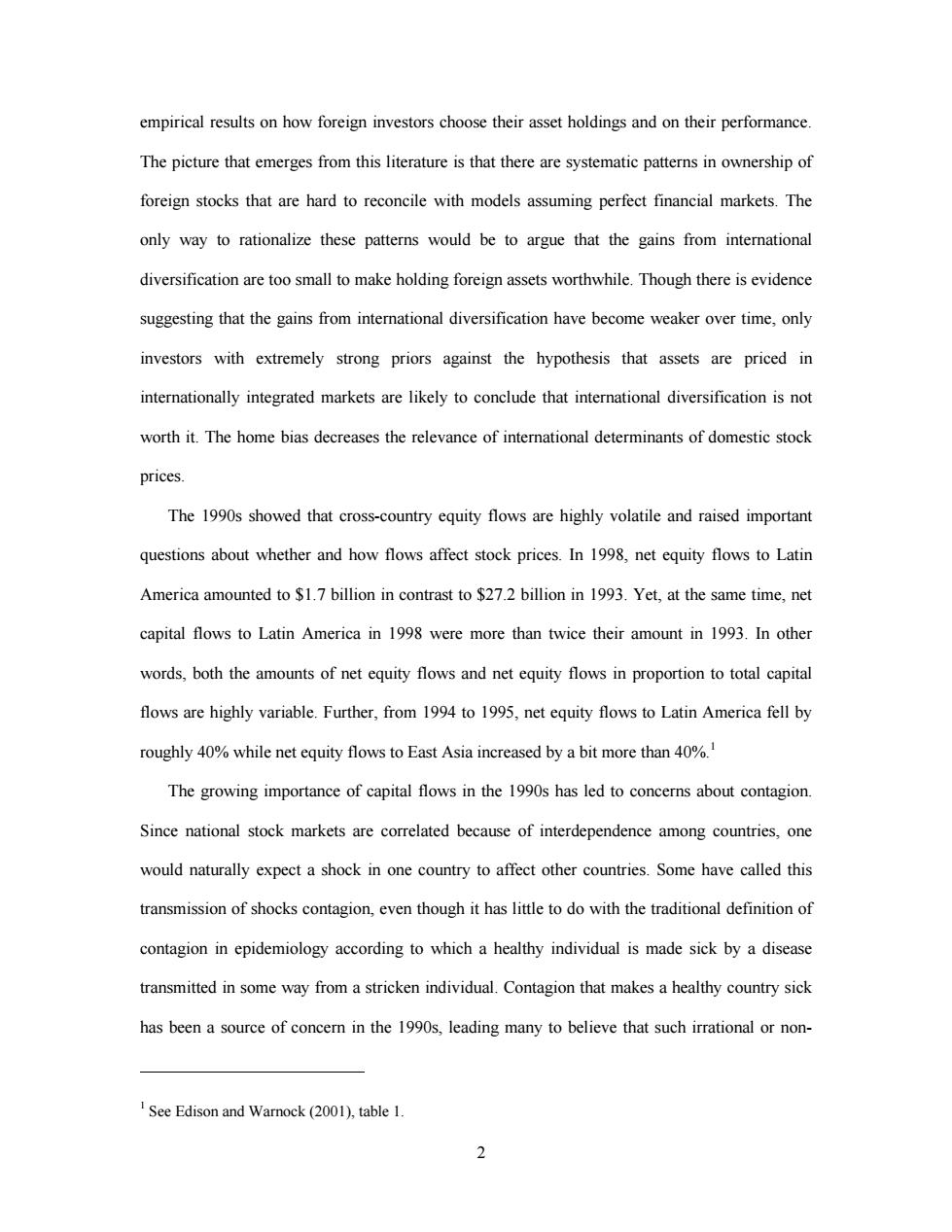正在加载图片...

empirical results on how foreign investors choose their asset holdings and on their performance. The picture that emerges from this literature is that there are systematic patterns in ownership of foreign stocks that are hard to reconcile with models assuming perfect financial markets.The only way to rationalize these patterns would be to argue that the gains from international diversification are too small to make holding foreign assets worthwhile.Though there is evidence suggesting that the gains from international diversification have become weaker over time,only investors with extremely strong priors against the hypothesis that assets are priced in internationally integrated markets are likely to conclude that international diversification is not worth it.The home bias decreases the relevance of international determinants of domestic stock prices. The 1990s showed that cross-country equity flows are highly volatile and raised important questions about whether and how flows affect stock prices.In 1998,net equity flows to Latin America amounted to $1.7 billion in contrast to $27.2 billion in 1993.Yet,at the same time,net capital flows to Latin America in 1998 were more than twice their amount in 1993.In other words,both the amounts of net equity flows and net equity flows in proportion to total capital flows are highly variable.Further,from 1994 to 1995,net equity flows to Latin America fell by roughly 40%while net equity flows to East Asia increased by a bit more than 40%. The growing importance of capital flows in the 1990s has led to concerns about contagion. Since national stock markets are correlated because of interdependence among countries,one would naturally expect a shock in one country to affect other countries.Some have called this transmission of shocks contagion,even though it has little to do with the traditional definition of contagion in epidemiology according to which a healthy individual is made sick by a disease transmitted in some way from a stricken individual.Contagion that makes a healthy country sick has been a source of concern in the 1990s,leading many to believe that such irrational or non- I See Edison and Warnock(2001),table 1. 22 empirical results on how foreign investors choose their asset holdings and on their performance. The picture that emerges from this literature is that there are systematic patterns in ownership of foreign stocks that are hard to reconcile with models assuming perfect financial markets. The only way to rationalize these patterns would be to argue that the gains from international diversification are too small to make holding foreign assets worthwhile. Though there is evidence suggesting that the gains from international diversification have become weaker over time, only investors with extremely strong priors against the hypothesis that assets are priced in internationally integrated markets are likely to conclude that international diversification is not worth it. The home bias decreases the relevance of international determinants of domestic stock prices. The 1990s showed that cross-country equity flows are highly volatile and raised important questions about whether and how flows affect stock prices. In 1998, net equity flows to Latin America amounted to $1.7 billion in contrast to $27.2 billion in 1993. Yet, at the same time, net capital flows to Latin America in 1998 were more than twice their amount in 1993. In other words, both the amounts of net equity flows and net equity flows in proportion to total capital flows are highly variable. Further, from 1994 to 1995, net equity flows to Latin America fell by roughly 40% while net equity flows to East Asia increased by a bit more than 40%.1 The growing importance of capital flows in the 1990s has led to concerns about contagion. Since national stock markets are correlated because of interdependence among countries, one would naturally expect a shock in one country to affect other countries. Some have called this transmission of shocks contagion, even though it has little to do with the traditional definition of contagion in epidemiology according to which a healthy individual is made sick by a disease transmitted in some way from a stricken individual. Contagion that makes a healthy country sick has been a source of concern in the 1990s, leading many to believe that such irrational or non- 1 See Edison and Warnock (2001), table 1